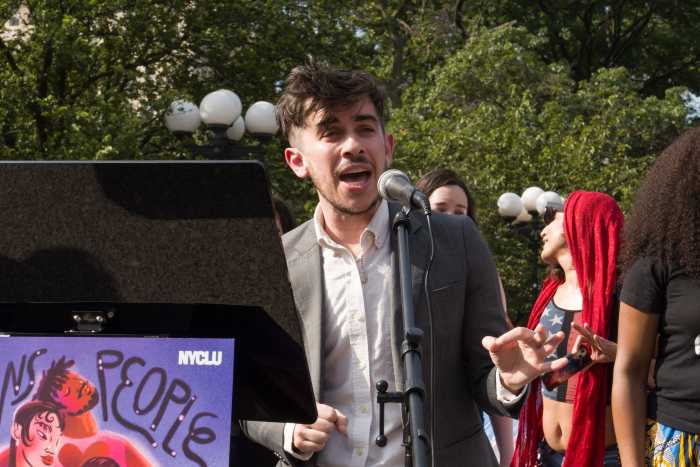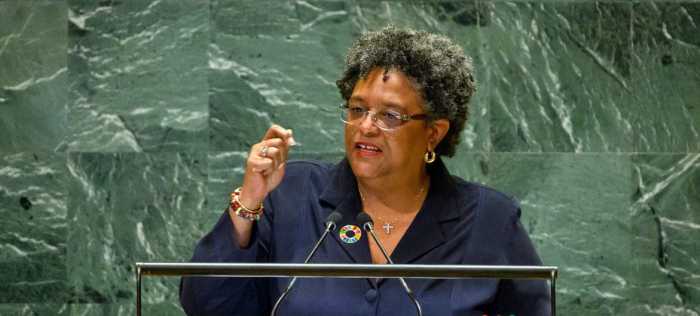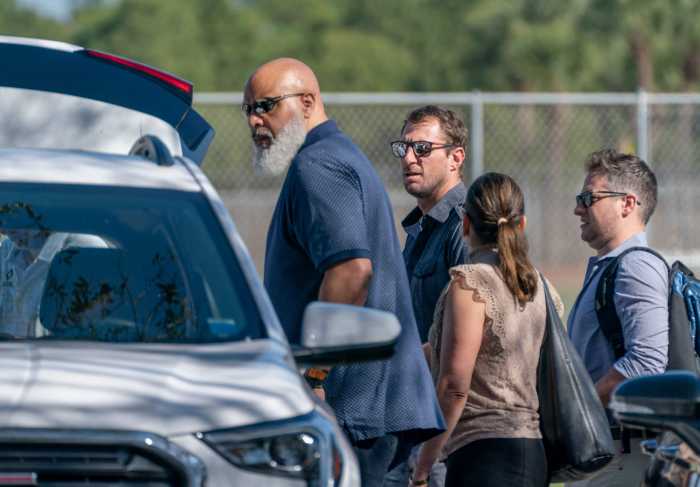Virginia Democratic Attorney General Mark Herring after officiating at the wedding of Carol Schall and Mary Townley, the marriage equality plaintiffs in that state, who are seen here with their daughter Emily. | TWITTER/ AGMARKHERRING
The Supreme Court’s October 6 decision to deny review in five marriage equality cases will have a quick echo effect –– expanding the victory in the five states being contested to another six under the jurisdiction of the three federal court circuits that issued the rulings that were allowed to stand.
The high court denied petitions for review of appellate court gay marriage victories in Virginia, Indiana, Wisconsin, Utah, and Oklahoma. In these cases, the US Courts of Appeals for the Fourth, Seventh, and 10th Circuits had ruled in recent months that same-sex couples have a right under the 14th Amendment to marry and to have their out-of-state marriages recognized.
Each of those rulings had been stayed pending Supreme Court action. Now that the high court has refused to review these cases, the stays will be lifted and five more states will quickly be added to the existing marriage equality list, which already includes 19 states and the District of Columbia.
With lawsuits pending before federal trial judges in another six states within the jurisdiction of the Fourth and 10th Circuits –– West Virginia, North Carolina, South Carolina, Wyoming, Colorado, and Kansas –– the respective judges are likely to grant summary judgment motions by the plaintiffs quickly, since their rulings are controlled by the courts of appeals that ruled in either the Virginia or the Utah and Oklahoma cases.
In the coming weeks, then, marriage equality will spread to these states as well, reaching a total of 30 states that have 60 percent of the nation’s population. That figure is very close to the tipping point of 34 states that allowed interracial marriages when the Supreme Court struck down Virginia’s miscegenation ban in 1967.
With the October 6 announcement, marriage equality has swept the Seventh Circuit, since Illinois adopted legislation allowing same-sex couples to marry last year and Wisconsin and Indiana are the only other states in the circuit.
Still to be heard from are the Sixth Circuit, where the court of appeals heard oral arguments on cases from all four states under its jurisdiction (Michigan, Ohio, Kentucky, and Tennessee) early in August, and the Ninth Circuit, where the court of appeals heard arguments from Idaho and Nevada early in September. The other states in the Ninth Circuit where marriage equality cases are pending in federal trial courts include Alaska, Montana, and Arizona. Four states in the Ninth Circuit already have marriage equality –– California, Hawaii, Oregon, and Washington.
Observers of the Sixth Circuit oral arguments had predicted that this might be the first circuit to rule against gay marriage, but the Supreme Court’s action might influence how those judges are thinking about the issue. There was no dissent from the high court’s denial of review, which means none of the justices was willing to go on record in opposition to lifting the stays and allowing marriage equality to go into effect in 11 more states. This may send some sort of signal to the lower courts.
In the Ninth Circuit, it is widely expected that the court — which previously struck down California’s Proposition 8 –– will rule for marriage equality, especially since a recent precedent there established heightened judicial scrutiny as the appropriate level of review for sexual orientation discrimination claims. Court observers believe marriage bans cannot survive that demanding standard of review.
Least far along are the Fifth, Eighth, and 11th Circuits. In the Fifth, the court has yet to schedule arguments on appeals from district court rulings in Texas and Louisiana, although it recently granted a motion to expedite briefing and hear arguments in those cases on the same day, probably in November.
The other state in that circuit is Mississippi, where litigation is pending in the trial court.
In the Eighth Circuit, Minnesota and Iowa already have marriage equality, and an appeal is pending before the Arkansas Supreme Court of a marriage equality ruling by a state trial judge. Cases are pending in trial courts in the remaining states in that circuit –– North and South Dakota, Nebraska, and Missouri, where a state court judge ruled on October 3 that same-sex marriages from other states must be recognized. Missouri officials have not announced whether they will appeal that ruling.
In the 11th Circuit, the court has yet to schedule an argument on Florida’s appeal from a trial court pro-marriage equality ruling, and cases are pending in federal trial courts in Georgia and Alabama.
Not to be forgotten are cases pending in Puerto Rico and the Virgin Islands, which are in the First and Third Circuits, respectively. Every state in both circuits already has marriage equality, though neither circuit court has ruled on the question.
A decision by the Supreme Court to deny a petition for review is not a decision on the merits of the case. The court’s decision to allow marriage equality to go into effect in five states (and, by extension, 11 states) without ruling on the merits was not widely anticipated, but it may have struck the justices as a prudent course of action.
Justice Ruth Bader Ginsburg –– a likely marriage equality supporter who has already officiated at several same-sex marriages and was part of the majority that struck down the Defense of Marriage Act last year –– observed in a recent talk at the University of Minnesota Law School that she saw no urgency for the Supreme Court to get involved as long as there was no disagreement among the circuit courts of appeals.
There was, of course, human urgency, if not legal urgency, because the rulings affecting five states had been stayed, but that urgency is immediately removed by lifting the stays and allowing those decisions to go into effect.
Trends in public opinion may have been the prudent ground on which the court chose not to intervene at this point. As more states have allowed same-sex couples to marry, popular support for the issue has grown. As a result, a pro-marriage equality ruling down the line might prove less controversial than might have been the case had the court decided the issue when “only” 19 states allowed same-sex marriage.
Some have even speculated that the high court abstaining from the issue might allow marriage equality to take effect nationwide without it playing any affirmative role. Even though denying review is not a decision, lower federal courts may be influenced by it in deciding the remaining cases.
It takes just four votes to grant review in an appeal. If the four most conservative Republicans — Chief Justice John Roberts and Justices Antonin Scalia, Clarence Thomas, and Samuel Alito –– presumably opposed to marriage equality based on their dissenting opinions in the DOMA case, thought they had a chance of picking up the vote of Justice Anthony Kennedy, author of the DOMA majority opinion, they would likely have voted to grant review in one or more of these cases.
The four Democratic appointees –– Justices Ginsburg, Stephen Breyer, Sonia Sotomayor, and Elena Kagan –– presumably marriage equality supporters based on their DOMA votes (and Kagan, like Ginsburg, has also officiated at a same-sex marriage), may agree with Ginsburg that there is no need to vote for review unless and until a circuit split develops.
No need tempting fate on either side, given Kennedy’s public silence on the matter.
The justices maintain absolute secrecy about what is said in their private conferences, so we may never learn what Kennedy may or may not have said in last week’s conference to persuade his four Republican colleagues and his four Democratic colleagues to refrain from voting to grant review. It seems a good bet, however, that he gave no hope to the Republicans that they were likely to get his vote for a decision reversing these court of appeals rulings.
This gives grounds for optimism that if the issue does get to the Supreme Court in its current configuration, it will likely be decided in favor of marriage equality. Time might change that calculus if a vacancy develops on the high court, but that’s another story.



































